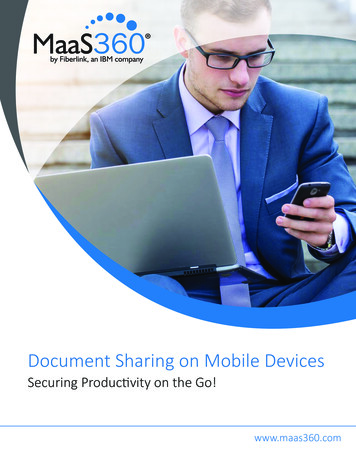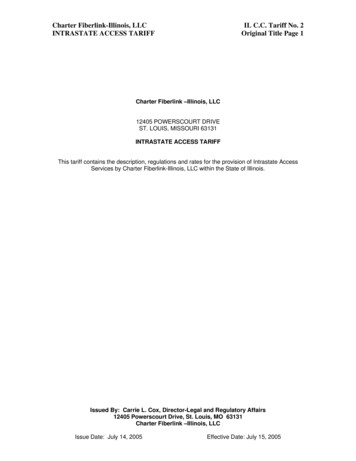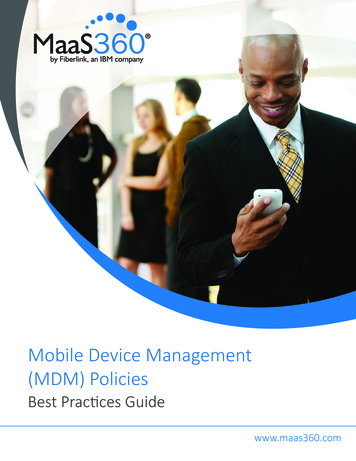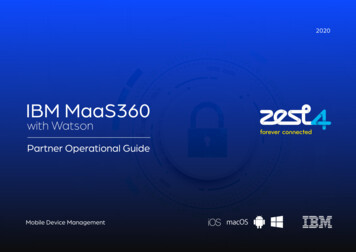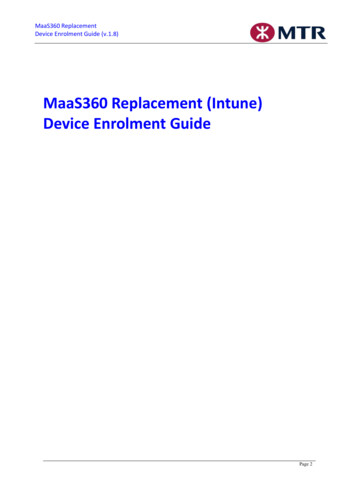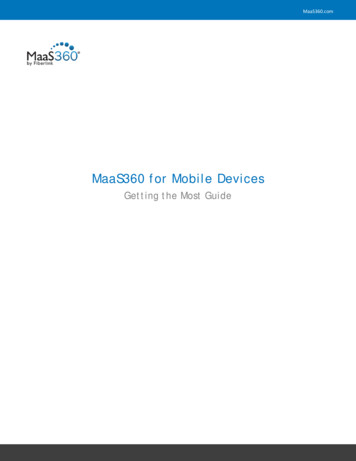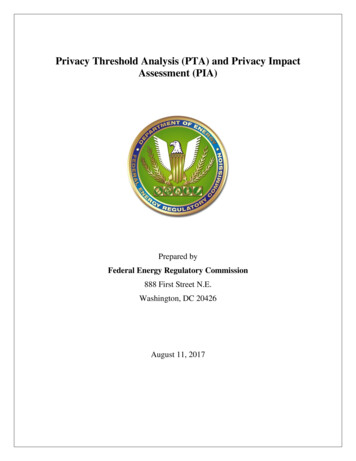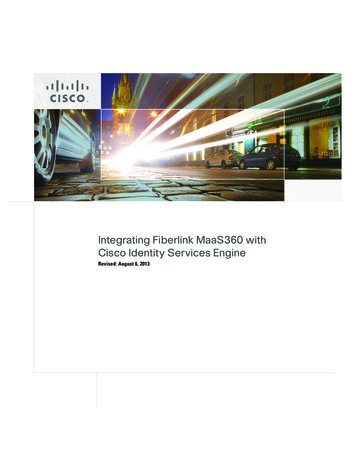
Transcription
Integrating Fiberlink MaaS360 withCisco Identity Services EngineRevised: August 6, 2013
2
ALL DESIGNS, SPECIFICATIONS, STATEMENTS, INFORMATION, ANDRECOMMENDATIONS (COLLECTIVELY, "DESIGNS") IN THIS MANUAL AREPRESENTED "AS IS," WITH ALL FAULTS. CISCO AND ITS SUPPLIERS DISCLAIM ALLWARRANTIES, INCLUDING, WITHOUT LIMITATION, THE WARRANTY OFMERCHANTABILITY, FITNESS FOR A PARTICULAR PURPOSE ANDNONINFRINGEMENT OR ARISING FROM A COURSE OF DEALING, USAGE, OR TRADEPRACTICE. IN NO EVENT SHALL CISCO OR ITS SUPPLIERS BE LIABLE FOR ANYINDIRECT, SPECIAL, CONSEQUENTIAL, OR INCIDENTAL DAMAGES, INCLUDING,WITHOUT LIMITATION, LOST PROFITS OR LOSS OR DAMAGE TO DATA ARISING OUTOF THE USE OR INABILITY TO USE THE DESIGNS, EVEN IF CISCO OR ITS SUPPLIERSHAVE BEEN ADVISED OF THE POSSIBILITY OF SUCH DAMAGES.THE DESIGNS ARE SUBJECT TO CHANGE WITHOUT NOTICE. USERS ARE SOLELYRESPONSIBLE FOR THEIR APPLICATION OF THE DESIGNS. THE DESIGNS DO NOTCONSTITUTE THE TECHNICAL OR OTHER PROFESSIONAL ADVICE OF CISCO, ITSSUPPLIERS OR PARTNERS. USERS SHOULD CONSULT THEIR OWN TECHNICALADVISORS BEFORE IMPLEMENTING THE DESIGNS. RESULTS MAY VARY DEPENDINGON FACTORS NOT TESTED BY CISCO.The Cisco implementation of TCP header compression is an adaptation of a program developedby the University of California, Berkeley (UCB) as part of UCB’s public domain version of theUNIX operating system. All rights reserved. Copyright 1981, Regents of the University ofCalifornia.Cisco and the Cisco Logo are trademarks of Cisco Systems, Inc. and/or its affiliates in the U.S.and other countries. A listing of Cisco’s trademarks can be found athttp://www.cisco.com/go/trademarks. Third party trademarks mentioned are the property of theirrespective owners. The use of the word partner does not imply a partnership relationship betweenCisco and any other company. (1005R)Any Internet Protocol (IP) addresses and phone numbers used in this document are not intendedto be actual addresses and phone numbers. Any examples, command display output, networktopology diagrams, and other figures included in the document are shown for illustrative purposesonly. Any use of actual IP addresses or phone numbers in illustrative content is unintentional andcoincidental.Integrating Fiberlink MaaS360 with Cisco Identity Services Engine 2013 Cisco Systems, Inc. All rights reserved.Integrating Fiberlink MaaS360 with Cisco Identity Services Engine3
Integrating Fiberlink MaaS360 with CiscoIdentity Services EngineThis document supplements the Cisco Bring Your Own Device (BYOD) rprise/Borderless Networks/Unified Access/BYODDesign Guide.html) and provides mobile device management (MDM) partner-specific information asneeded to integrate with Cisco ISE. In an effort to maintain readability, some of the informationpresented in the CVD is repeated here. However this document is not intended to provide standaloneBYOD guidance. Furthermore, only a subset of the Fiberlink MaaS360 functionality is discussed.Features not required to extend ISE’s capabilities may be mentioned, but not in the detail required for acomprehensive understanding. The reader should be familiar with the Fiberlink MaaS360Administrator’s guide.This document is targeted at existing or new Fiberlink MaaS360 customers. Information necessary toselect an MDM partner is not offered in this document. The features discussed are considered to be corefunctionality present in all MDM software and are required to be compatible with the ISE API.OverviewFiberlink MaaS360 secures and manages BYOD and company provided smartphones and tablets. Thiscloud-based service provides IT administrators the ability to quickly on-board and proactively secureiOS, Android, BlackBerry, and Kindle devices. Fiberlink MaaS360 also provides pre-built integrationswith critical enterprise security, identity, email, and mobility infrastructure for a seamless enterprisemobility and collaboration experience on both campus WLAN and carrier networks.Fiberlink MaaS360 Capabilities and FeaturesFiberlink MaaS360 provides the life-cycle management capabilities and features highlighted in Table 1.Corporate Headquarters:Cisco Systems, Inc., 170 West Tasman Drive, San Jose, CA 95134-1706 USACopyright 2013 Cisco Systems, Inc. All rights reserved.
Table 1Fiberlink MaaS360—Key CapabilitiesCapabilityArchitecture andAdminintrationDevice EnrollmentProactive DeviceSecurityCentral PolicyManagementFeatures SaaS delivery model Multi-tenant, scalable, and redundant cloud architecture Independent SOC2 Type II cloud compliance audit conducted annually Safe Harbor Certification for European Union Directive on Data Protection Authority to operate (OTA) in accordance with U.S. Federal Information Security ManagementAct (FISMA) Role-based admin access to Fiberlink MaaS360 Admin Portal Custom branding capabilities API support Multiple mobile OS support including iOS, Android, BlackBerry, Windows, and Kindle Select device management services and configure device enrollment settings on FiberlinkMaaS360 Admin Portal Send enrollment requests over the air using SMS, email, or a custom URL Authenticate users against Active Directory/LDAP, one- time passcode, or SAML Create and distribute customized acceptable use policies and End User License Agreements(EULA) Enroll both corporate and employee owned (BYOD) devices Initiate either individual or bulk device enrollments Apply or modify default device policy settings Require passcode policies with configurable quality, length, and duration Enforce encryption and password visibility settings Set device restrictions on features, camera, applications, iCloud, and content ratings Detect and restrict jail broken and rooted devices Remotely locate, lock, and wipe lost or stolen devices Selectively wipe corporate data, leaving personal data intact Define and implement real-time compliance rules with automated actions Enable geo-fencing rules to enforce location related compliance Configure email, calendar, contacts, Wi-Fi, and VPN profiles over-the-air (OTA) Approve or quarantine new mobile devices on the network Create custom groups for granular or role-based policy management Define role-based administrative portal access rights to Fiberlink MaaS360 Admin Portal Decommission devices by removing corporate data and mobile device management controlIntegrating Fiberlink MaaS360 with Cisco Identity Services Engine5
Table 1Fiberlink MaaS360—Key CapabilitiesEnterprise ApplicationCatalog Manage and distribute third-party and in-house mobile apps from the Fiberlink MaaS360 AdminPortal Develop a catalog of recommended mobile apps on iOS and Android devices Users can view apps, install, and be alerted to updated apps on private app catalog Manage lifecycle of app workflow:– Real-time software inventory reports– App distribution and installation tracking– App update publishing– Provisioning profile management Administer mobile app security and compliance policies:– Blacklist and whitelist mobile apps downloaded from Apple App Store and Google Play– Enforce out-of compliance rules by sending user alerts, blocking email or VPN, and remotewiping– Limit native apps available on the device such as YouTube– Require user authentication and authorization before they download in-house apps– Detailed reporting across app compliance events and remediation actions Host and distribute in-house mobile apps on Fiberlink MaaS360 Cloud Support for volume purchase programs on Apple App Store:– Automatically upload redemption codes in Fiberlink MaaS360 Cloud– Track provisioning, manage licenses, monitor compliance, and eliminate manual VPPmanagementSecure ContentDistribution Securely access, view, and share documents in the Doc Catalog on iPads, iPhones, and AndroidDevices Add additional security with native device encryption, passcode, and remote wipe of lost orstolen devices Support for multiple document formats including:– Microsoft– Google– Apple Productivity Suites– PDF, web, audio, and video files6 Host documents on a corporate network or on Fiberlink MaaS360 Cloud Block documents from being opened in file sharing or word processing applications for data lossprevention Set policies on certain documents to restrict them from being emailed from corporate or personalaccounts Alert users on new or updated content in their Doc Catalog without the need to manually checkfor updates Generate reports on documents, users, and devices to monitor status and usage for complianceIntegrating Fiberlink MaaS360 with Cisco Identity Services Engine
Table 1Monitoring andReportingEnterpriseIntegrationsFiberlink MaaS360—Key Capabilities Detailed hardware and software inventory reports Configuration and vulnerability details Integrated smart search capabilities across any attribute Customizable watch lists to track and receive alerts BYOD privacy settings block collection of personally identifiable information Mobile expense management for real-time data usage monitoring and alerting Instant discovery of devices accessing enterprise systems with Fiberlink MaaS360 Connector Integrate with Microsoft Exchange, Lotus Notes, and Microsoft Office 365 including:– Microsoft Exchange 2007 and 2010– BPOS and Office 365– Lotus Traveler 8.5.2 Integrate with existing Active Directory/LDAP and Certificate Authorities Manage BlackBerry Enterprise Server policies on BlackBerry Enterprise Server 5.0 and higher Connect with other operational systems through web APIsThe Fiberlink MaaS360 solution has three main components: Portals (Administration and End User) Fiberlink MaaS360 Server in the Cloud that manages policies and compliance rules Fiberlink MaaS360 Agent software that runs on mobile devicesBeyond these, there is an additional component for enterprise integration called FiberlinkMaaS360 Cloud Extender that integrates with AD, LDAP, email servers, and the PKIinfrastructure. The majority of the base functionality is available through the MDM API built intothe mobile device operating system. Fiberlink MaaS360 requires the client software to detect someconditions, such as jail-broken or rooted devices. Because ISE tests for these conditions, theFiberlink MaaS360 server is configured to treat the client software as a required application andwill install the software during the on-boarding process.Deployment ModelsFiberlink MaaS360 offers only a cloud-based service model. To integrate with enterprise backendsystems, customers need to install Fiberlink MaaS360 Cloud Extender software on either aphysical or virtual machine within their network. Fiberlink MaaS360 Cloud Extender islightweight software that establishes outbound connection with the Fiberlink MaaS360 cloud.There is no requirement to open any inbound firewall ports to support the Fiberlink MaaS360Cloud Extender.Integrating Fiberlink MaaS360 with Cisco Identity Services Engine7
Getting Fiberlink MaaS360 Ready for ISEThe first requirement is to establish basic connectivity between the Cisco ISE server and the FiberlinkMaaS360 MDM server. A firewall is typically located between ISE and the Fiberlink MaaS360 cloud.The firewall should be configured to allow an HTTPS session from ISE located in the data center to theFiberlink MaaS360 server located in the public Internet. The session is established outbound from ISEtowards the MDM where ISE takes the client role. This is a common direction for web traffic overcorporate firewalls.Figure 1Traffic Through FirewallCisco cateAuthorityImport MDM Certificate to ISEThe Fiberlink MaaS360 MDM server incorporates an HTTPS portal to support the various users of thesystem. In the case of a cloud service, this website will be provided to the enterprise and ISE mustestablish trust with this website. Even though the cloud website is authenticated with a publicly signedcertificate, ISE does not maintain a list of trusted root CAs. Therefore the administrator must establishthe trust relationship. The simplest approach is to export the MDM site certificate, then import thecertificate into a local cert store in ISE. Most browsers allow this. Internet explorer is shown in Figure 2with a cloud-based MDM deployment.8Integrating Fiberlink MaaS360 with Cisco Identity Services Engine
Figure 2Exporting the MDM Site Certificate with Internet ExplorerFiberlink MaaS360 utilizes a wildcard certificate that is valid for all portal websites belonging tothe Fiberlink MaaS360 portals domain.Exporting a certificate from Firefox is covered in the CVD and repeated in Figure 3.Figure 3Exporting the MDM Site Certificate with FirefoxIntegrating Fiberlink MaaS360 with Cisco Identity Services Engine9
Figure 4Importing the Certificate in ISEGrant ISE Access to the Fiberlink MaaS360 APIThe Fiberlink MaaS360 API is protected by HTTPS and requires an administrator account that has beengranted permission to the API. Ideally a specific account would be configured for ISE with a very strongpassword. In addition to this account, only a limited number of administrator accounts should be grantedthe ability to create new administrators or assign administrator roles.Before the user is created, an API role should be created for ISE, as shown in Figure 5. This role willthen be tied to an administrator account assigned to ISE along with a location group for the account.Administrators can manage the system settings assigned to their role, which can be selected on a per rolebasis. Additional details concerning location groups are available in the Fiberlink MaaS360documentation. A local administrator account is required for the REST MDM API roles to functionproperly.10Integrating Fiberlink MaaS360 with Cisco Identity Services Engine
Figure 5Manage Administrator AccountEach account type can be assigned roles entitling that user to specific features of the system. Alsothe role of service administrator can be used to manage the API from ISE.Integrating Fiberlink MaaS360 with Cisco Identity Services Engine11
Figure 6Add AccountThe MDM role created for ISE requires the REST API features. The list shown in Figure 7 identifies therights which should be selected.12Integrating Fiberlink MaaS360 with Cisco Identity Services Engine
Figure 7Assign Role to the AccountOnce the role as been added, an admin account can be created for ISE.Add MDM Server to ISEOnce the account has been defined on the Fiberlink MaaS360 MDM server with the proper roles,ISE can be configured to use this account when querying the MDM for device information. ISEwill contact the MDM to gather posture information about devices or to issue device commands,such as corporate wipe or lock. The session is initiated from ISE towards the MDM server. Asshown in Figure 8, the URL for the Fiberlink MaaS360 server and the configuration is illustrated.This is configured under Administration Network resources MDM.Integrating Fiberlink MaaS360 with Cisco Identity Services Engine13
Figure 8Configure the MDM API on ISEThe polling interval specifies how often ISE will query the MDM for changes to device posture. Pollingcan be disabled by setting the value to 0 minutes. Polling can be used to periodically check the MDMcompliance posture of an end station. If the device is found to be out of MDM compliance and the deviceis associated to the network, then ISE will issue a Change of Authorization (CoA), forcing the device tore-authenticate. Likely the device will need to remediate with the MDM, although this will depend onhow the ISE policy is configured. Note that MDM compliance requirements are configured on the MDMand are independent of the policy configured on ISE. It is possible, although not practical, to set thepolling interval even if the ISE policy does not consider the MDM Compliant dictionary attribute.The advantage of polling is that if a user takes the device out of MDM compliance, they will be forcedto reauthorize that device. The shorter the window, the quicker ISE will discover the condition. Thereare some considerations to be aware of before setting this value. The MDM compliance posture couldinclude a wide range of conditions not specific to network access. For example, the device administratormay want to know when an employee on a corporate device has exceeded 80% of the data plan to avoidany over usage charges. In this case, blocking network access based solely on this attribute wouldaggravate the MDM compliance condition and run counter the device administrator’s intentions. Inaddition, the CoA will interrupt the user Wi-Fi session, possibly terminating real-time applications suchas VoIP calls.The polling interval is a global setting and cannot be set for specific users or asset classes. Therecommendation is to leave the polling interval at 0 until a full understanding of the MDM’sconfiguration is complete. If the polling interval is set, then it should match the device check-in perioddefined on the MDM. For example, if the MDM is configured such that devices will report their statusevery four hours, then ISE should be set to the same value and not less than half this value. Oversamplingthe device posture will create unnecessary loads on the MDM server and reduced battery life on themobile devices. There are other considerations with respect to scan intervals. Changing MDM timersshould be done only after consulting with Fiberlink MaaS360 best practices.14Integrating Fiberlink MaaS360 with Cisco Identity Services Engine
The Test Connection button will attempt to log in to the API and is required prior to saving thesettings with the MDM set to Enable. If the test does not complete successfully, the settings canstill be saved, but the Enable box will be deselected and the MDM will not be active.Verify Connectivity to MDMSome problems can occur when testing the connection to the MDM server. Table 2 shows somecommon messages generated when testing the connection between ISE and Fiberlink MaaS360.The last message shown below confirms a successful connection.Table 2MessageConnection MessagesExplanationA routing or firewall problem exists between theISE located in the data center and the MDMlocated in either the DMZ or Cloud. The firewall’sconfiguration should be checked to confirmHTTPS is allowed in this direction.The most likely cause of an HTML 404 error codeis that an instance was configured when it was notrequired or that the wrong instance has beenconfigured.The user account setup on the Fiberlink MaaS360server does not have the proper roles associated toit. Validate that the account being used by ISE isassigned the REST API MDM roles as shownabove.The user name or password is not correct for theaccount being used by ISE. Another less likelyscenario is that the URL entered is a valid MDMsite, but not the same site used to configure theMDM account above. Either of these could resultin the Fiberlink MaaS360 server returning anHTML code 401 to ISE.Integrating Fiberlink MaaS360 with Cisco Identity Services Engine15
Table 2Connection MessagesMessageExplanationISE does not trust the certificate presented by theFiberlink MaaS360 website. This indicates thecertificate was not imported to the ISE certificatestore as described above or the certificate hasexpired since it was imported.The connection has successfully been tested. Theadministrator should also verify the MDMAUTHZ dictionary has been populated withattributes.Review MDM DictionariesWhen the Fiberlink MaaS360 MDM becomes active, ISE will retrieve a list of the supported dictionaryattributes from the MDM. Currently Fiberlink MaaS360 supports all of the attributes that ISE can query.This should remain true so long as both ISE and the MDM are running the latest release code. Thedictionary attributes are shown in Figure 9.Figure 916Dictionary AttributesIntegrating Fiberlink MaaS360 with Cisco Identity Services Engine
Enterprise IntegrationFiberlink MaaS360 offers a solution that enables integration with existing enterpriseinfrastructures such as AD, Exchange, and a certificate authority. This is achieved using acomponent called Fiberlink MaaS360 Cloud Extender. The Fiberlink MaaS360 Cloud Extender isa small program that runs as a service on a Microsoft Windows machine in your network. TheCloud Extender creates an outbound connection over HTTPS to the Fiberlink MaaS360 portal thatis used as a bi-directional communication facility and allows the Fiberlink MaaS360 portal tointegrate with an enterprise Active Directory Server to perform user authentication andsynchronization of users and groups using Active Directory. The Fiberlink MaaS360 CloudExtender requires that it be configured with an account with sufficient rights to run as a serviceand to have read-only access Active Directory.Fiberlink MaaS360 Cloud Extender can be installed on a Physical or Virtual Machine withfollowing specifications: Windows Server 2008 R2 (64-bit) Dual Core, 4 GB RAM Access to Fiberlink MaaS360 Cloud (outbound connection, port 443) Read-only Administrative access to AD to real user and group informationRedundancy configurations are available but are out of scope for this document. For moreinformation, see: https://www.cisco.com/go/Fiberlink MaaS360support.Typical Cloud Deployment ModelInternetDMZInternal NetworkCisco ISEAD/LDAPHTTPSEmailAdmin rLinkCloudCSRCertificateEnrollmentServerUser oudExtenderGCMiOS andAndroid Agents294254Figure 10Integrating Fiberlink MaaS360 with Cisco Identity Services Engine17
The installation of the Cloud Extender is straightforward and fully documented by Fiberlink MaaS360.All the information required to install is available by logging onto Fiberlink MaaS360 and going toSETUP Enrollment Settings, as shown in Figure 11.Figure 11Fiberlink MaaS360 Cloud Extender DownloadWhen Cloud Extender is installed, Installation Wizards guide the administrator to configure AD for userauthentication and User Visibility. User Visibility allows Fiberlink MaaS360 to import groups that areprovisioned in AD. Figure 12 and Figure 13 show Installation Wizard screens to configure ADintegration on Fiberlink MaaS360. Enter the values for Corporate Identifier provided by FiberlinkMaaS360 and also enter the AD domain name during the installation steps.18Integrating Fiberlink MaaS360 with Cisco Identity Services Engine
Figure 12Cloud Extender Installation WizardIntegrating Fiberlink MaaS360 with Cisco Identity Services Engine19
Figure 13Cloud Extender AD ConfigurationActive Directory/LDAP IntegrationIntegrating ISE and the MDM to a common directory is important for overall operations. One benefit isthe ability to set a requirement that a user periodically change their directory password. If the MDM wereusing a local directory, it would be nearly impossible to keep the accounts in synchronization. But witha centralized directory structure, password management can be simplified. The main advantage is theability to establish complementary network and device policy base on group membership. The CVDprovides examples of how groups can be used to establish a user’s entitlement to network resources.Likewise, the same group membership can be used to differentiate access to device resources and mobileapplications.AD Group MembershipsThree possible AD groups are presented in the CVD to illustrate their usage—Domain Users,BYOD Partial Access, and BYOD Full Access. ISE establishes the device’s network access based onthe associated user’s membership.Figure 14 shows the policies presented in the CVD.20Integrating Fiberlink MaaS360 with Cisco Identity Services Engine
Figure 14CVD Use PoliciesThese groups can be extended to the MDM such that members are issued profiles that complementtheir level of network access. As an example, Table 3 shows some arbitrary policies that can beestablished and enforced based on the CVD use cases.Table 3Policies Based on CVD CasesOwnershipUser GroupRestrictionsEmployee-OwnedDeviceDomain UsersInternet Only, personal devices are notrequired to on-board with the MDM.BYOD Partial AccessFairly restrictive policy that isolatescorporate data into containers. Restrictionsprevent users from disabling the policy.BYOD Full AccessTrusted users are offered a slightly lessrestrictive policy. Corporate data is stillisolated in containers.All Users classesVery restrictive device policy disablingnon-essential business functions such asthe game center.Corporate-OwnedDeviceDomain Users is the default AD group. By definition, every user defined in the directory is adomain user. While it is possible to create the reciprocal group on the MDM, it is not needed. TheCVD treats non-domain members as temporary guests that are unlikely to need MDMmanagement. More important, if a user is not a domain member, then the MDM administrator willneed to define a local user account. This is likely a very small set of users that are handled as anexception, such as distinguished guests. Domain Users are essentially everyone with an accounton the MDM, including members of BYOD Partial Access and BYOD Full Access.MDM profiles and ISE AuthZ rules are fundamentally different with respect to AD Groups. ISEpolicy may include the AD group match as a condition for establishing a specific and single policy.MDM profiles are not a singular result. Most devices will be provisioned with multiple profilesbased on various attributes. Members of the BYOD Full Access and Domain Users can each beconfigured for a specific profile. But if a user happens to have membership in bothBYOD Partial Access and BYOD Full Access, then that user’s device is provisioned with bothprofiles. In addition, everyone will be provisioned with basic security restrictions. ISE will checkthe device to ensure these restrictions are meet before granting network access. These restrictionsestablish ISE compliance and are defined here as required PIN lock, encrypted storage, andnon-jail broken or rooted device.Integrating Fiberlink MaaS360 with Cisco Identity Services Engine21
MDM ProfilesDevice profiles are an important concept of mobile device management. They are defined as part of theMDM protocol implemented by the operating system. The concept can be extended to applicationprofiles, but as discussed here, they are found under the settings of the device. Each profile can containone or more payloads. A payload has all the attributes needed to provision some aspect of built-in systemfunctions, such as PIN lock and Device Restrictions. Android and Apple differ in what payloads aresupported. One special payload will be an MDM payload that defines the MDM server as the deviceadministrator. There can only be one MDM payload installed on any device. The profile containing theMDM payload may not be locked and the user is free to delete it at any time. When this occurs, all otherprofiles installed by the MDM are also removed, essentially resulting in a corporate wipe.The MDM may lock any profile that it installed to prevent the user from removing them individually.The MDM is allowed to inspect other profiles, such as the Wi-Fi profile installed by ISE, but is notallowed to remove any profile that it did not install. Since multiple profiles can be installed on a deviceand profiles have payloads, it is possible to have a payload collision. Devices with multiple securitypayloads will install all the payloads by aggregating the most secure settings from each. In most othercases the first payload is installed and subsequent payloads are ignored or multiple payloads areaccepted. For example, the device can have multiple VPNs provisioned, but only one can be named XYZ.MDM profiles can be applied to devices associated to users that belong to a user group. Configuring thiswith Fiberlink MaaS360, administrator will take following steps:1.Configure Fiberlink MaaS360 Cloud Extender to import groups from Corporate Directory.2.Create profiles as desired for different AD Group Types.3.Bind Profiles to AD groups.Figure 15 shows the creation of a profile.On Fiberlink MaaS360 Administration Portal, Go to Security Policy Add Policy to create policies.22Integrating Fiberlink MaaS360 with Cisco Identity Services Engine
Figure 15Create PoliciesTo bind policies to user groups, Go to Users Groups and assign appropriate policy, as shown inFigure 16.Integrating Fiberlink MaaS360 with Cisco Identity Services Engine23
Figure 16Binding Policies to User GroupsWith the example configuration shown above, users that belong to BYOD Employee Access will getFull Access policy pushed to their devices. User will see two profiles installed by ISE and two or threefrom the MDM. The server will install the MDM payload during the on-boarding process. After thatprofile has been installed, the device will be issued a check-in request via APNS or GCM. When thedevice responds to the push notice, it will connect to the MDM where any additional profiles areinstalled.Figure 17 shows the flow of this process.24Integrating Fiberlink MaaS360 with Cisco Identity Services Engine
Figure 17Enrollment Network ProfileMobileconfig(mdm, cert)APNSRegistrationMDM PFiberlink MaaS360 can provision certificates onto the device via SCEP-PROXY. This allowsprofiles to contain a payload that provisions a service that requires authentication via a certificateand another payload contains the associated certificate. One such example is VPN payload foreither AnyConnect or Cisco IPsec. This is discussed in more detail in Application Distribution.Mobile Client Application—Fiberlink MaaS360 AgentAs discussed in the BYOD CVD, before the Fiberlink MaaS360 agent is installed, SoftwareProvisioning Wizards (SPW) must be downloaded from Cisco site. For Apple iOS devices, accessto the application store is not
BYOD guidance. Furthermore, only a subset of the Fiberlink MaaS360 functionality is discussed. Features not required to extend ISE's capabilities may be mentioned, but not in the detail required for a comprehensive understanding. The reader should be familiar with the Fiberlink MaaS360 Administrator's guide.
